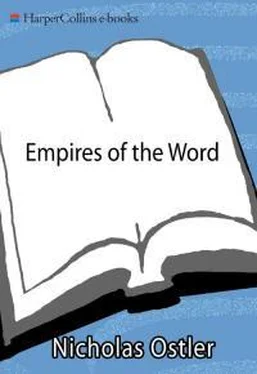The Italian Pigafetta, accompanying the Spanish circumnavigators in 1521, had been able to compile a list of 450 Malay words at Tidore in the Moluccas. Nevertheless, it was not yet well established there: ‘even the scribes who had to write it for the infant Sultan of Tidore in 1521 and 1522 showed that they were “certainly very imperfectly acquainted with it’” (Hoffman 1979: 66-7, n. 9).
There was always speculation that the strange unwillingness of the Dutch to share their language with their colonial subjects was a sort of snobbery, to enhance their prestige among the Dutchless natives. This was roundly discouraged by the Dutch administration as a harmful attitude. Nevertheless, it was widely believed by foreign observers (e.g. Bousquet 1940: 88-9); and it did happen to fit in with a certain aspect of Javanese etiquette, whereby social status was marked by styles of language ( taalsoorten).
It might even be seen, by an unsympathetic Anglo-Saxon, as an example of ‘that tipsy, euphoristic prose-poetry which is one of the more tiresome manifestations of the French spirit’, a phrase of Peter Medawar in a review of Teilhard de Chardin’s Le Phénomène humain (accessible at http://cscs.umich.edu/-crshalizi/Medawar/phenomenon-of-man.html).
The term was invented by the geographer Onésime Reclus in 1880, to refer to the French-speaking community in the world. Nowadays, at least in the French-speaking world, it refers preferably to a voluntary association of states under a charter, not all of them ex-colonies of France, in spirit rather comparable with the British Commonwealth. (See .)
These figures are from Grimes (2000). The French Foreign Ministry’s francophonie website claims that there are 160 million first-language and second-language speakers. Leclerc (2000) states that 145 million people have been to school in French. Either figure might lift its rank above German, but not to the level of Portuguese.
Je is a remnant of what was once a Latin pronoun of emphasis, ego (brutally reduced, after changing to something like eieu —cf. the Provençal equivalent, eu, ieu).
There will be more to say of this retreat of French, from the viewpoint of the language that benefited from it, in the next chapter.
The term, and the institution, continued in the Mediterranean until the nineteenth century, but the actual language used was based not on French but Italian, probably because of the later influence of merchants from Venice.
Eleanor (Aliénor) of Aquitaine (1122-1204) played a cardinal role as a cultural sponsor. She could hardly have been better connected in society, being the wife of two kings, mother of two, and the mother-in-law of yet two more. But in the mid-twelfth century she made her court at Poitiers a centre for courtly love poetry and historical narrative.
It has continued to enjoy the sponsorship of the highest level in French government ever since, broken only during the Revolution in 1793-1803. Its first task was to compile a dictionary; the first edition took almost sixty years, coming out in 1694, but it has been updated periodically ever since, the latest edition, the eighth, appearing in 1992.
Hence the bon mot of Antoine de Rivarol, in his Discours sur l’universalité de la langue française , of 1784: ’Ce qui n’est pas clair n’est pas français!’ (’What is not clear is not French!’),
’Eh bien, mon prince, Gěnes et Lucques ne sont plus que des apanages, des, de la famille Buonaparte. Non. je vous préviens, que si vous ne me dites pas, que nous avons la guerre, si vous vous permettez encore de pallier toutes les infamies, toutes les atrocités de cet Antichrist (ma parole, j’ y crois)—je ne vous connais plus, vous n’ětes plus mon ami, vous n’ětes plus, comme vous dites.’
In the eighteenth century, it yielded only to Spain; in the twentieth, only to Britain.
Estimates of the French-speaking population of Algeria vary from the Ethnologue ’s almost absurdly low 110,000 (out of a population of 30 million) to 25 per cent of the population (i.e. 7.5 million). Many believe that it is still the second-largest francophone population in the world, ahead of Quebec with 6.7 million, and Belgium with 4 million. (These latter figures also come from the Ethnologue —Grimes 2000.) It is widely believed that the Algerian government’s attempted ‘arabisation’ since 1962 has perversely increased use of other languages, notably Berber and French; but no survey data is available.
One village he visited near Quebec City was known as ganāda , ‘settlement’ in the Huron language, which served as lingua franca along the river. This is the origin of the name Canada.
The mission flourished, although it did not lead to any French settlement at the time; indeed, de Rhodes was the only Frenchman in a Jesuit team consisting of six Europeans and a Japanese. However, the need to protect the missions was later used to justify the massive French invasion of Indo-china which came in 1859. And de Rhodes himself is significant as the man who devised the script now known as Quôc-ngu (  , ‘National Language’), using Roman letters and accents. He had designed it as an aid to foreign missionaries learning Vietnamese. But in the late nineteenth century it was taken up, even by nationalists, as the key to mass literacy, and is now used universally in Vietnam.
, ‘National Language’), using Roman letters and accents. He had designed it as an aid to foreign missionaries learning Vietnamese. But in the late nineteenth century it was taken up, even by nationalists, as the key to mass literacy, and is now used universally in Vietnam.
The poor Acadians were to fall victim to great power politics, their lands traded to England under the Treaty of Utrecht in 1713 in return for trading concessions in India. They were subsequently scattered along the coast, especially in Maine and the mouths of the Mississippi (where they became known as ‘Cajuns’), some in the Antilles and many back to the maritime provinces. Wherever they went, French-speaking communities sprang up, at least for a time.
This can hardly have been a fundamental cause, since two decades later it was French naval power which crucially denied the British access to America when they were trying to hold on to their own colonies.
The French had the satisfaction of providing Versailles as the site for the 1783 conference that divested Britain of its American colonies, just twenty years after the Paris conference when the British had taken Nouvelle-France from them.
These figures are drawn from a French source, Leclerc (2001, <). There is amazing discrepancy with some English figures: e.g., Mackey (1998) says that 100,000 loyalists joined an existing population of 65,000 French and 9000 English.
Cayenne was founded in 1643 and with Caribbean sugar aplenty had been part of Colbert’s plans for systematic colonisation. It was briefly used after the French Revolution as a place of exile for political prisoners (1794-1805). It never recovered economically from France’s abolition of slavery in 1848, and thereafter was famous mainly for its prison camp, Devil’s Island, in operation from 1852 to 1946.
Читать дальше

 , ‘National Language’), using Roman letters and accents. He had designed it as an aid to foreign missionaries learning Vietnamese. But in the late nineteenth century it was taken up, even by nationalists, as the key to mass literacy, and is now used universally in Vietnam.
, ‘National Language’), using Roman letters and accents. He had designed it as an aid to foreign missionaries learning Vietnamese. But in the late nineteenth century it was taken up, even by nationalists, as the key to mass literacy, and is now used universally in Vietnam.









